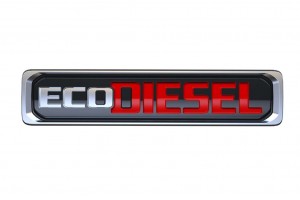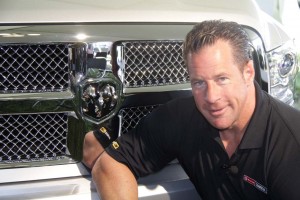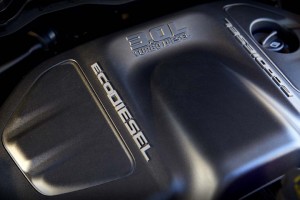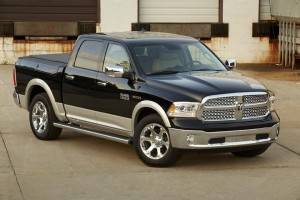Chrysler is throwing down the gauntlet, its Ram truck division planning to become the first maker to offer a high-mileage diesel in its light-duty pickup line.
Ram, which is expected to post its 39th consecutive monthly sales increase next week, is betting that this will give it a critical advantage over competitors both domestic and foreign at a time when fuel prices continue to hover just below $4 a gallon in much of the country. The question is whether potential buyers will balance the initial, $2,800 price premium against the longer-term savings on fuel.
“When you look at the psyche of pickup truck owners,” Reid Bigland, the CEO of the Ram division, said during a preview of the new powertrain, “they’re more aware of the benefits of a diesel engine” than the general U.S. population.
Diesels typically deliver as much as 30% higher mileage than a comparable gasoline engine. But what Ram officials believe could prove equally significant for customers is the high-torque nature of the diesel in a business where stump-pulling power is as, perhaps more, important than off-the-line accelerations.
Despite its relatively modest 3.0-liter displacement, Ram’s new turbodiesel makes 240-horsepower and 420 pound-feet of torque. That’s roughly equivalent to the maker’s big 5.7-liter Hemi V-8, even while the diesel is expected to deliver fuel economy closer to the Ram 1500’s V-6 option.
At the moment, the maker has not come up with final, EPA-approved mileage numbers, though Bigland cautions the Ram 1500 will likely get slightly less than the 30 mpg the new, 3.0-liter diesel-powered version of the Jeep Grand Cherokee is offering.
(Ford slings mud at Ram with its new F-150 tremor sport truck. Click Here for more.)
The $2,800 premium isn’t the only thing working against a diesel comeback in the U.S., though. There’s also the higher cost of the fuel, typically running about the same – or even higher – than unleaded premium gasoline.
Even so, Bob Hegbloom, the Ram brand marketing chief, claimed that all-in, “under three years from an efficiency standpoint is all it’s going to take to pay for itself.” And, considering the average pickup on the road today is about 12 years old, Hegbloom said the lifetime savings due to the diesel’s better fuel economy will be measures in the thousands of dollars.
There is, of course, the general disdain Americans have had since the 1980s, CEO Bigland acknowledged, due to the generally coarse, rough-riding and smelly diesels of that era. The challenge will be to convince potential buyers that the latest diesel technology is smooth and clean while also powerful and fuel-efficient.
There are signs that U.S. motorists are catching on. European makers are reporting steadily increasing sales – Volkswagen struggling to come up with enough diesel engines to meet demand for some of its passenger car and SUV models, such as the Passat. Its sibling Audi brand will launch three new diesels for the 2014 model-year and another for 2015.

US consumers have long avoided diesels, but Ram hopes rising fuel prices - and improved diesel technology - will change perceptions.
Mazda is adding a new diesel powertrain for its Mazda6 sedan line this coming year.
And even General Motors is adding a diesel for its compact Cruze line for 2014 – its first passenger car diesel in over a quarter century.
But while the domestic makers have long had oil-burner options for their heavy-duty trucks, Ram is the first, and for now only, brand to offer a diesel in a light-duty pickup.
“It will be a great differentiator,” said Bigland, noting Ram has already driven its market share from around 11.5% of the pickup segment to nearly 20% since parent Chrysler emerged from Chapter 11 in 2009.
He hinted the maker foresees the new diesel will account for at least 10% of Ram sales as customers become more aware of the option, but he added, “That could go to 20, 25, even 30%.”
“It’s sure going to put other makers on the spot,” concurred analyst Joe Phillippi, of AutoTrends Consulting.
The competition, including Toyota and Nissan as well as segment dominant General Motors and Ford, have dropped hints, in recent months, they may be looking at diesel options. GM, in fact, had largely finished development of a light-duty diesel, dubbed the Baby Max, prior to its 2009 bankruptcy. And Phillippi said that if GM felt the need, it could be put into a truck in as little as one to two years.
Ford, however, continues to emphasize its EcoBoost, a turbocharged V-6 gasoline engine, as a diesel alternative. It this week introduced a new EcoBoost-powered sport truck spin-off of its full-sized F-150 model, dubbed Tremor.
But if Ram’s new 3.0-liter diesel delivers the buyers, Phillippi and other analysts suggest, the competition will be under severe pressure to respond with oil-burners of their own in short order.




These two statements strike me as contradictory, and even more so, considering Ram’s gas V6 is 3.6 litres vs. Diesel V6’s 3.0:
“Diesels typically deliver as much as 30% HIGHER mileage that a comparable gas engine.”
“…the diesel is expected to deliver fuel economy CLOSER to Ram 1500’s V-6 option.”
What am I missing?
By comparable gas engine, Sid, we refer to the output, performance, towing capacity of the diesel. It is not a reference to displacement or cylinders. So, the 3.0-liter diesel, as I also mention in the story, has much the same capabilities as the Hemi V-8, especially in terms of what usually matters to truckers: payload and towing (signaled by its hefty, 420 lb-ft of torque). Even so, the diesel will likely be getting V-6 gas engine fuel economy, probably as good or better than the 3.6 gas engine.
Paul A. Eisenstein
Publisher, TheDetroitBureau.com
As someone who’s driven diesel cars for 30 years (Mercedes ’83 – 2012, VW the past year) and lives part time in an Italian city where 83% of cars are diesel, it is a mystery why they are ubiquitous in the US. The Chrysler minivan has a 2.8L turbodiesel in Europe, also the Dodge Journey, also the “new” Ford Escape (called ‘Kuga’ in Europe where its been sold since Jan. ’09). If US drivers could feel the power and see the 30+ mpg economy when they fill up, they’d flock to them! Not to mention the smaller cars sold here that jump from 26 mpg overall to 40+ overall with their little powerful diesels.
It’s about time…
The U.S. truck/SUV makers should have offered a small Diesel engine in the 1/2 ton pick-ups and big SUVs at least 5 years ago. Fiat blew it when they bought Chrysler. Cummins had/has a small inline six cylinder Diesel fully developed and ready to start shipping to Dodge for the 1/2 ton trucks and SUVs. That all came to a screaching halt with the Fiat buy-out.
The V-6 Diesel which typically is not as good as an inline 6 Diesel for torque and mpg, is made by a European subsidiary that Fiat owns. Time will tell if it is a worthy Diesel or another Diesel nightmare that will taint the U.S. consumer market as the 80’s U.S. car maker converted gas engines to Diesels, did.
The outrageous price gouging by the oil industry Cabal is why Diesel costs more than gasoline. There is no justification for the insane crude prices other than an industry monopoly. Consumers have the power but they won’t make a short term sacrifice for long term gains.
That being said Diesels deliver better real world mpg in virtually every case over a gas engine of remotely close capability. Diesels have a huge advantage in city driving mpg, lower actual maintenace costs and far better low speed torque than any gas engine even turbo gas engines. Diesels are the best choice for heavy vehicles or HD use, period. Ask anyone who has towed a trailer with both a gas and Diesel engine.
“The outrageous price gouging by the oil industry Cabal is why Diesel costs more than gasoline”
Oh, if were just that simple the market place might be able to deal with it, but I think one of the other big reasons is, with diesel they can’t force you to buy Ethonal.
A federally mandated and tax payer suported disaster that we are all stuck with when using gosoline. It has less power, so you see an DECREASE in your mpgs. (the oil companies and government love that one.) The more of this crap in our tank the more fuel we have to buy, so oil company profits go up even more, and the Govt. gets more tax money from fuel sales.
Hence all the foot dragging and EPA rules on diesel fueled vehicles for the millions of passenger cars on the road.
I drive by the gas pumps in my VW Jetta TDI at 40 to 45 mpgs and pull up all the long grades in 6th gear, 2300 rpm while the Ethonal Challenged gassers are down shifted and screaming to find enough power to make the grade.